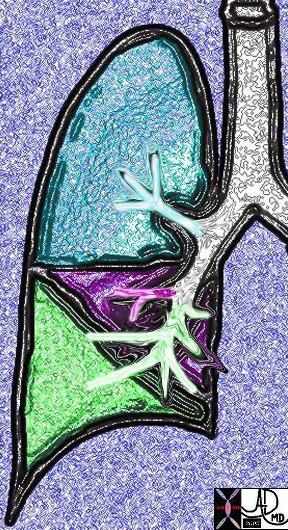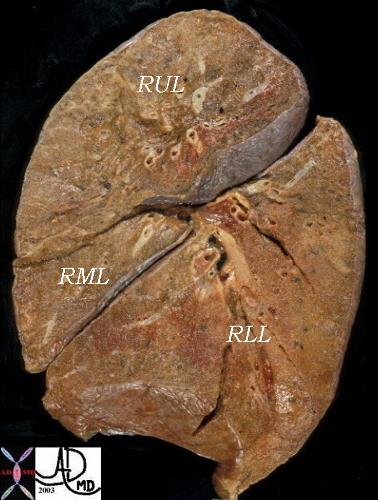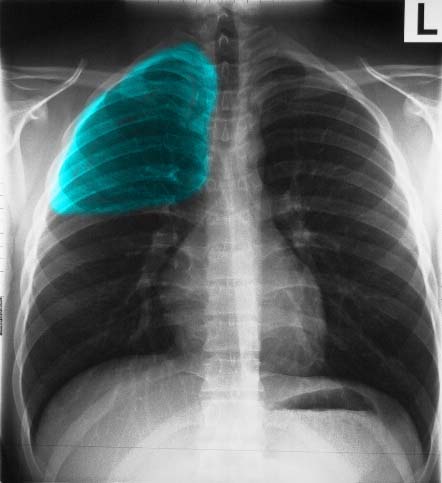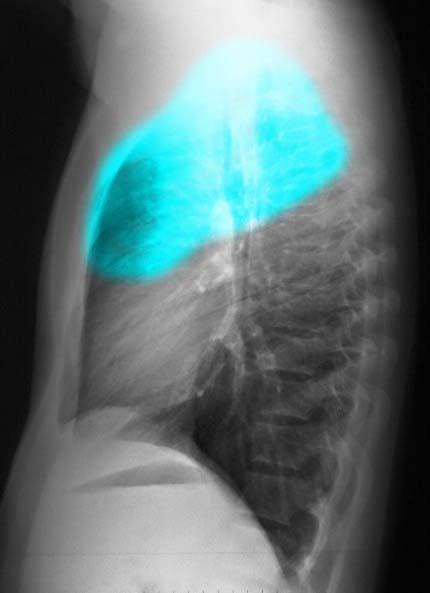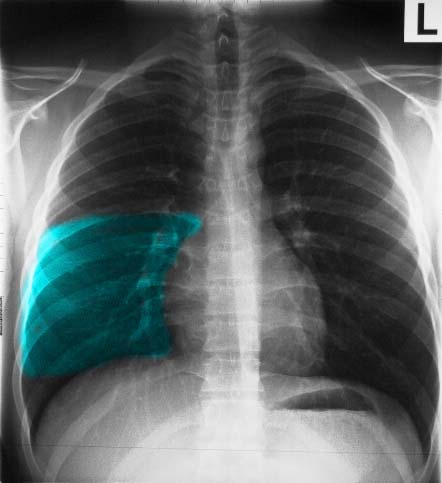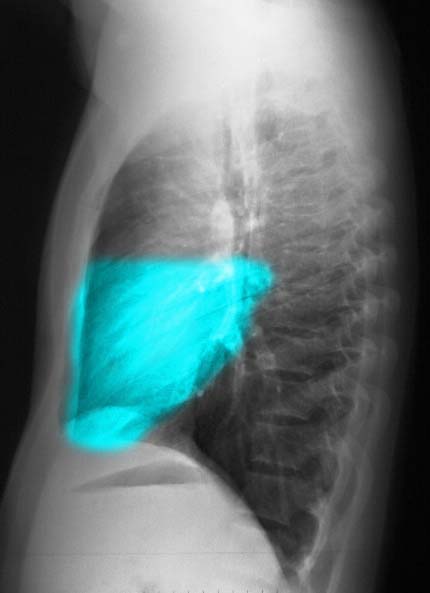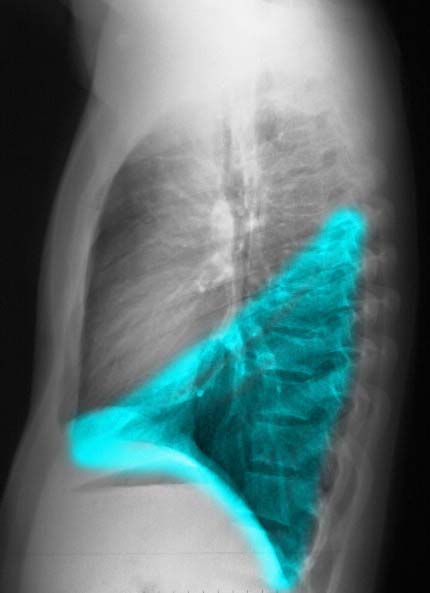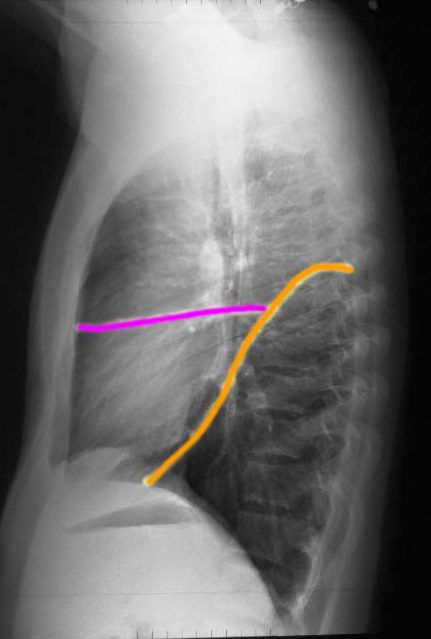Ashley Davidoff MD
-
MAP OF STRUCTURE
-
Airways
- Overview
- Acinus
- Alveolus
- Cells
- Carina
- Bronchi Mainstem
- Bronchi Segmental
- Bronchi Subsegmental
- Small Airways
- Bronchioles
- Terminal Bronchiole
- Respiratory bronchiole
- Bronchioles
- Secondary Lobule
- Trachea
- Map of Size of Parts of the Lung
- Right Lung
- Left Lung
- Overview
-
Vessels
- Pleura
-
Diaphragm
-
Chest Wall
-
Embryology and Growth
-
Miscellaneous
-
-
- Structural Pathway of Air in the Lungs
- with a focus on the histology
- Mediastinum
- Supporting Structures
- Structural Pathway of Air in the Lungs
-
-
-
-
FUNCTION
-
MAP OF DISEASES
-
DIAGNOSIS
-
MAP of FINDINGS
- MODALITIES
-
- CASE EXAMPLES
- and the
-
Right Lung Parts: Basic Anatomy
The right lung has three lobes: upper, middle, and lower. The lobes are subdivided into segments that are determined by the branching of the main bronchi. The right lung usually has 10 segments subtended by 10 segmental bronchi. The right upper lobe has three segments called the apical, posterior and anterior segments. The right middle lobe has two segments named the lateral and the medial segments. The right lower lobe has five segments also named according to position; superior, anterior basal, lateral basal, posterior basal, and medial basal segments. The superior segmental bronchus is the first branch of the RLL system and it is directed posteriorly. The superior segment is vulnerable in the supine patient who aspirates because of its posterior position.

Right lung
This diagram shows the segmental branches of the right bronchial system. The RUL has three branches, the apical, posterior and anterior segments. (teal overlay) The middle lobe has two segmental branches called lateral and medial segments. (pink) The right lower lobe has five: the superior, anterior basal, lateral basal, posterior basal and medial basal segments. Ashley Davidoff MD. TheCommonVein.net 32686b03The superior segment occupies the entire upper portion of the lower lobe. It sits atop the remaining four segments of the right lung: the anterior basal, lateral basal, posterior basal and medial basal segments. These basal segments form the base of the almost pyramidal shaped lower lobe as well as the base of the lung it and them rest upon the diaphragm.

Right lung
This pathologic specimen of the lung is viewed in the sagittal plane with the anterior aspect to your left. The RML is the triangular lobe in this projection and is the smallest of all the lobes. The RUL is above and the RLL which is inferior and posterior to the RML is the largest lobe of the right lung.
Ashley Davidoff MD. TheCommonVein.net 32159B03bRight Lung Parts: Applied
It is essential to know and understand the distribution of the lobes for accurate assessment of the CXR. For example, a disease process in the upper lung field on the right does not necessarily mean that the disease is in the RUL. Since the RLL is so large and extends almost the entire thoracic distance (see image 3a), it is difficult to localize on the P-A exam of the chest. However, if one reviews the lateral exam, the distinction between right upper and right lower lobe is much easier, since the lower lobe is mostly posterior and below the fissure, and the upper lobe mostly anterior and above the fissure.

RIGHT UPPER LOBE IN THE FRONTAL PROJECTION
Ashley Davidoff MD TheCommonVein.net 30397b01
LATERAL CXR SHOWING RIGHT UPPER LOBE
Ashley Davidoff MD TheCommonVein.net 30398b01
RIGHT MIDDLE LOBE IN THE FRONTAL PROJECTION
Ashley Davidoff MD TheCommonVein.net 30397b03
LATERAL CXR SHOWING RIGHT MIDDLE LOBE
Ashley Davidoff MD The Common Vein.net 30398b03The following images in P-A and lateral projection reveal the large posteriorly positioned right lower lobe (RLL). Note how much larger the RLL is compared to the RML and the RUL.

RIGHT LOWER LOBE IN THE FRONTAL PROJECTION
Ashley Davidoff MD TheCommonVein.net
LATERAL CXR SHOWING RIGHT LOWER LOBE
Ashley Davidoff MDThe major fissure is the dividing line between the RLL on the one hand and the RUL and RML on the other. The minor fissure, also known as the transverse fissure, divides the RUL from the RML and is easily perceived on the lateral examination.

LATERAL X-RAY SHOWING MAJOR and MINOR FISSURES DIVIDING THE RIGHT LUNG INTO 3 LOBES
The right lung has a relatively small right upper lobe (RUL) separated from the middle lobe (RML) by the minor fissure (pink,lower image). Both the RUL and RML are anterior and are separated from the lower lobe by the major fissure (orange line)
Ashley Davidoff MD. TheCommonVein.net 30398b06b
Fissures of the right lung
This lateral examination of the corresponding lung specimen in sagittal section demonstrates the major fissure in yellow/orange which divides the RLL from the RML and RUL. The minor fissure is in pink and it divides the RUL from the RML.
Ashley Davidoff MD. TheCommonVein.net 32159B06
Fissures of the right lung
This coronal reformats through the tracheobronchial tree show the major fissures bilaterally. They are usually quite difficult to see and unless you know where to look you may miss them altogether. Usually there is a hint of hypovascularity along the fissure resulting in a relative lucency as can be appreciated in this examination. The fissures have been overlaid in orange in the next image. As the coronal cut proceeds posteriorly the lower lobe becomes more prominent and the upper lobes less so. If you review the lateral chest x-ray and project the cuts you would get a better sense of this concept of the dominance of the RLL and its posterior location .
Ashley Davidoff MD. TheCommonVein.net 32682b

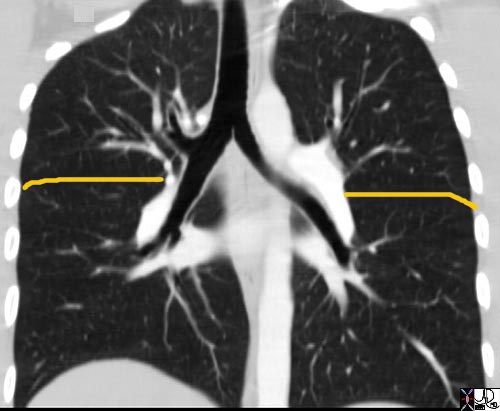
Fissures of the right lung
This coronal reformats through the tracheobronchial tree show the major fissures bilaterally. They are usually quite difficult to see and unless you know where to look you may miss them altogether. Usually there is a hint of hypovascularity along the fissure resulting in a relative lucency as can be appreciated in this examination. The fissures have been overlaid in orange. As the coronal cut proceeds posteriorly the lower lobe becomes more prominent and the upper lobes less so. If you review the lateral chest x-ray and project the cuts you would get a better sense of this concept of the dominance of the RLL and its posterior location .
Ashley Davidoff MD. TheCommonVein.net 32682b01.jpgSometimes there is an extra lobe in the right upper lung field called the azygous lobe and the azygous vein runs in the accessory fissure. The azygous lobe is an accessory lobe in the apex of the right lung that is found in approximately 0.5% of routine chest x-rays. It is recognized by a fissure in the apex that has an inverted comma shape.
The following diagram demonstrates the cross sectional appearance of the right lung at the level where both the major and minor fissures are seen. It correlates the CTscan with the anatomical specimen.

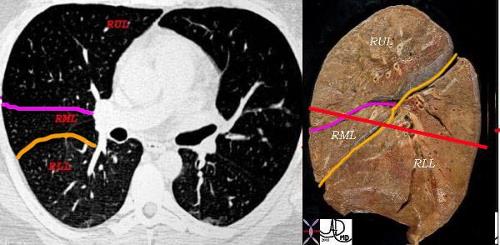
Fissures of the right lung – transverse view
This combination shows the two fissures of the right lobe on the CT scan separating the RLL from the RML (major fissure in orange) and the RML from the RUL. (minor or transverse fissure in pink) The anatomic specimen is in the sagittal plane with the posterior aspect to your right. The red line drawn through the specimen represents the level of the X-sectional plane revealing in sequence from posterior to anterior, the RLL, major fissure, RML, minor fissure, RUL. On the left side there is the faint hint of hypovascularity along the major fissure.
Ashley Davidoff MD. TheCommonVein.net 32160c2lb_6
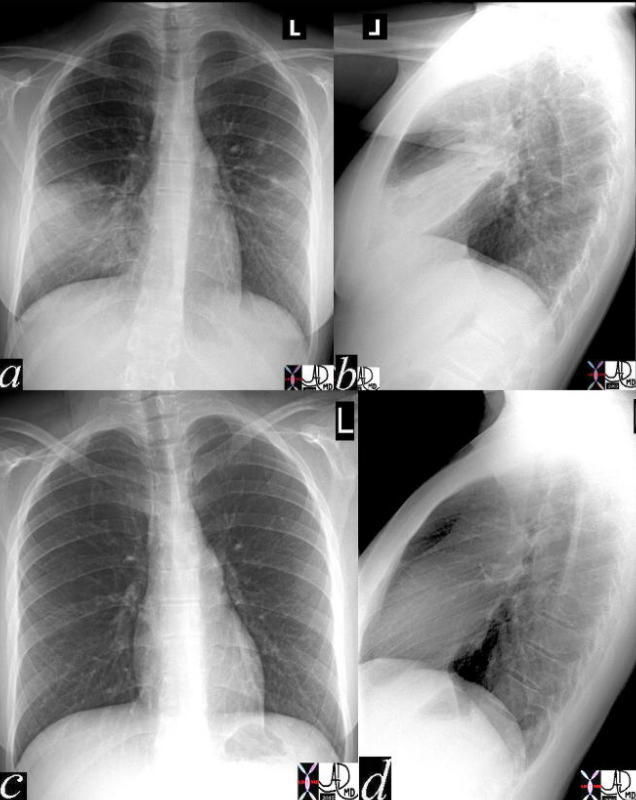
Classical RML pneumonia
key words medical students code chest CXR imaging lung plain film pneumonia radiology resolution
41819c02 Ashley Davidoff MD. TheCommonVein.net
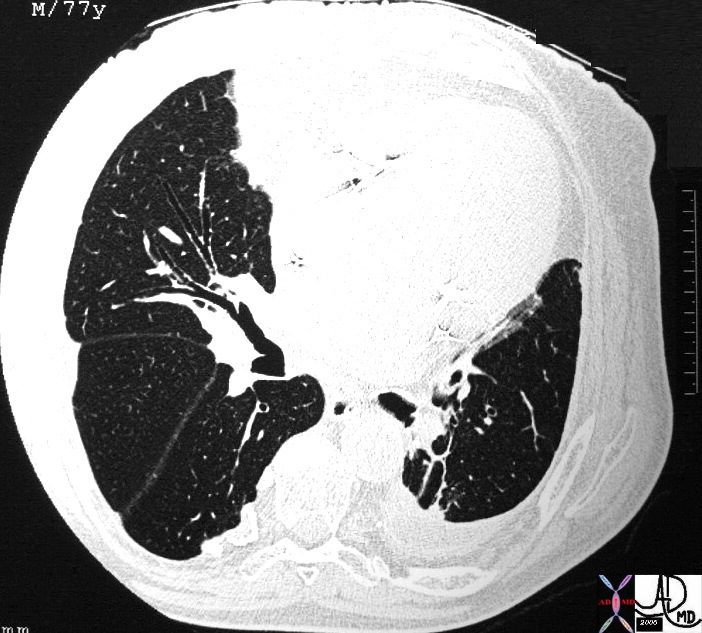
RML bronchus with Medial and Lateral Segments and Minor Fissure
31350 lung bronchus right middle lobe bronchus normal anatomy CTscan Ashley Davidoff MD. TheCommonVein.net 31350 - Left Lung Parts: Basic Anatomy The left and right lungs are very different. We have already noted that the mainstem bronchi are different, with the left mainstem bronchus being long and thin, while the right mainstem bronchus is short and fat. The left lung has only two lobes. There is a left upper lobe (LUL) and a left lower lobe (LLL). The left lung does not have a middle lobe. Instead, the middle lobe equivalent is the lingula, which is in fact part of the LUL and not a separate lobe. The two lobes of the left lung are separated by the major or oblique fissure, which is the only fissure on the left side. The left lung is smaller than the right and has 8 segments compared to the 10 segments on the right. The upper lobe of the left lung has superior and lingula divisions. Both of these divisions have two segments each. The segments of the superior division are the apical-posterior and the anterior segments. The lingula is divided into superior and inferior segments. As noted there is no fissure between the upper segments of the LUL and the lingula – they are both part of the LUL. The division of the lower lobe closely resembles that of the right except that there is consolidation of two of the left lower lobe segments. Thus while the RLL has 5 segments the LLL has only four. Again, as is characteristic, the left lung consolidates its component parts. The superior segment of the LLL forms the top of the pyramid of the LLL. Inferiorly and at the base of this pyramid, the anterior and medial segments combine to form the anteromedial basal segment, followed by the lateral basal, and posterior basal segments.

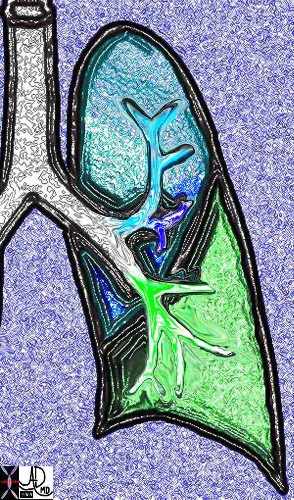
Left lung
This is a drawing is of a left lung in coronal section. Note there are only two lobes separated by the major fissure
Courtesy Ashley Davidoff MD The CommonVein.net 32686b05L01Left Lung Parts: Applied
The overall volume of the left lung is smaller than the right, but the distribution of volume between LUL and LLL is more equalized and balanced. Again in the P-A projection the two lobes overlap each other. A nodule in the upper lung field or lower lung field as seen on the P-A projection can be located either in the upper or lower lobe. The lateral examination is essential to accurately locate the disease. The LUL is anterior and above the fissure (see Fig 1b), while the LLL is posterior and below the fissure (see Fig 2b).

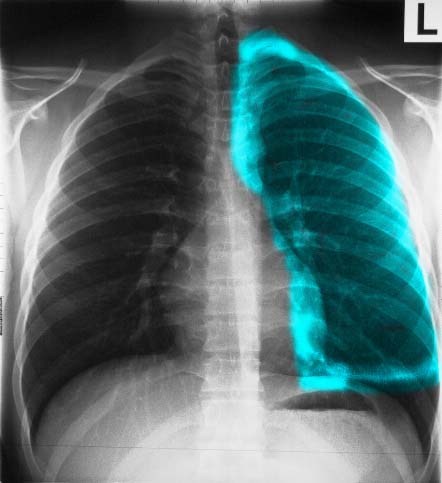
LEFT UPPER LOBE IN THE FRONTAL PROJECTION
The A-P examination of the chest shows the LUL, with the teal overlay representing the upper lobe and lingula.. Note how the lingula hugs the left heart border. Ashley Davidoff MD TheCommonVein.net 30397b05
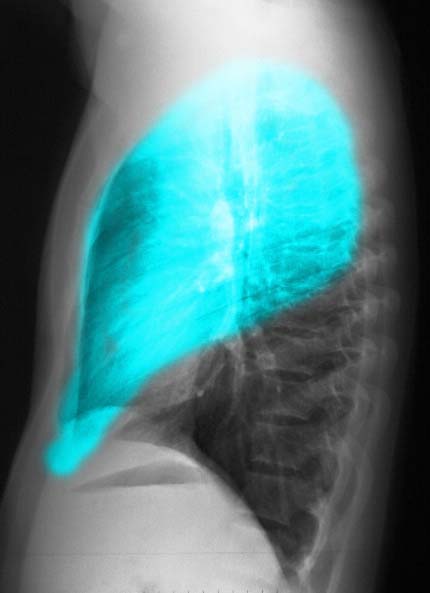
LATERAL PROJECTION, LEFT UPPER LOBE
Ashley Davidoff MD
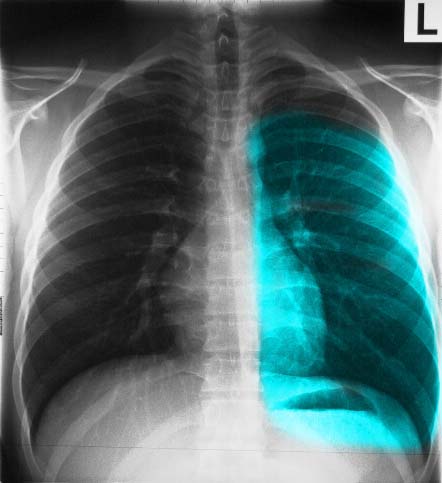
LEFT LOWER LOBE IN THE FRONTAL PROJECTION
The A-P examination of the chest shows the LLL, with the teal overlay. Note the similarity in size and shape of the LUL and LLL . Ashley Davidoff MD TheCommonVein.net
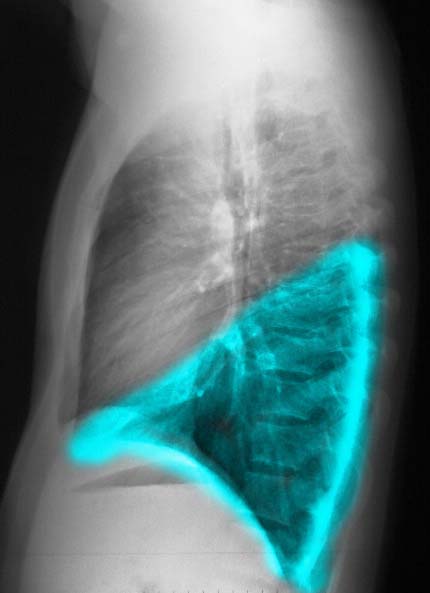
LATERAL CXR SHOWING LEFT LOWER LOBE
Ashley Davidoff MD TheCommonVein.net 30398b06


LATERAL PROJECTION – FISSURE DIVIDES THE LEFT UPPER LOBE (INCLUDING LINGULA) AND LEFT LOWER LOBE
Ashley Davidoff MD TheCommonVein.net
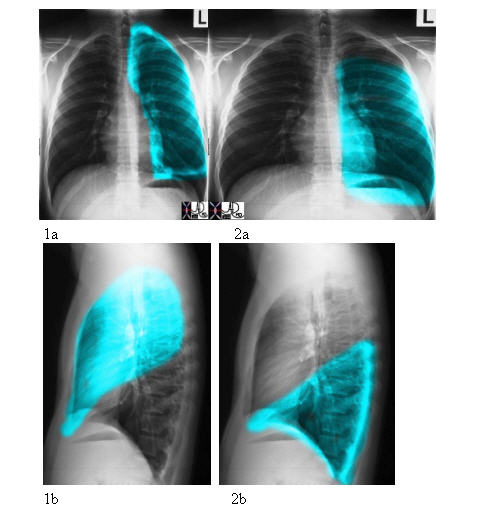
These images (left to right) show the LUL, and LLL. In Fig 1a and 1b the overlay represents the upper lobe and lingula. Image 2a and 2b represent the left lower lobe. Note how the lingula hugs the left heart border. The volumes of the LUL and LLL are about equal.
Courtesy of: Ashley Davidoff, M.D.
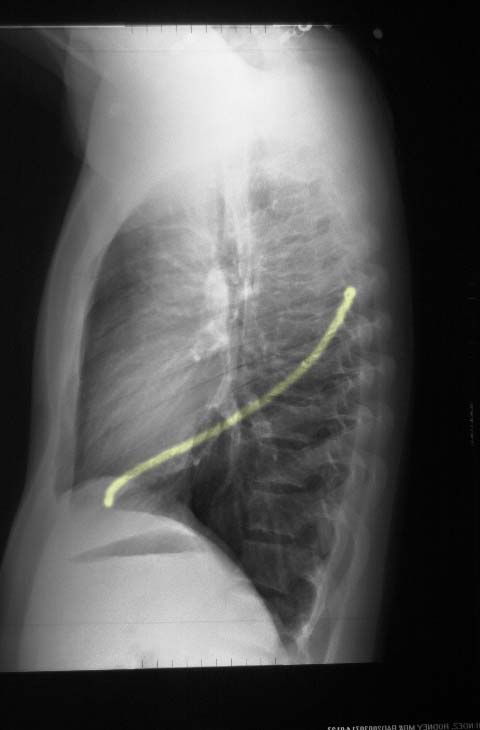
MAJOR FISSURE ON THE LEFT This lateral examination of the chest and corresponding lung specimen (follows) in sagittal section demonstrates the major fissure in yellow , which divides the LUL from the LLL.
Courtesy Ashley Davidoff MD The CommonVein.net 30399


LEFT MAJOR FISSURE The lateral projection shows the major fissure in orange which divides the left upper lobe, including the lingula from the left lower lobe.
Ashley Davidoff MD TheCommonVein.net
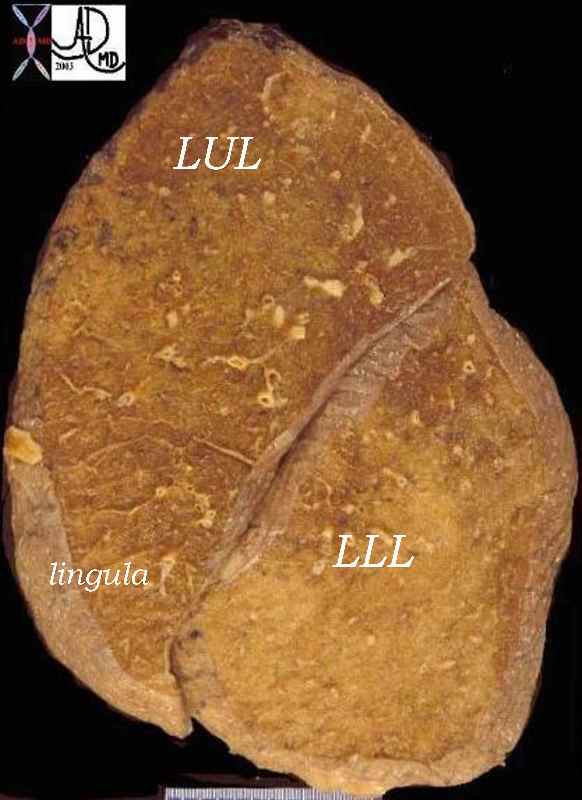
Major fissure – lateral exam – anatomy- FISSURE DIVIDES THE LEFT UPPER LOBE (INCLUDING LINGULA) AND LEFT LOWER LOBE This lung specimen in sagittal section demonstrates the major fissure , which divides the LUL including the lingula, from the LLL.
Ashley Davidoff MD TheCommonVein.net 32228b03

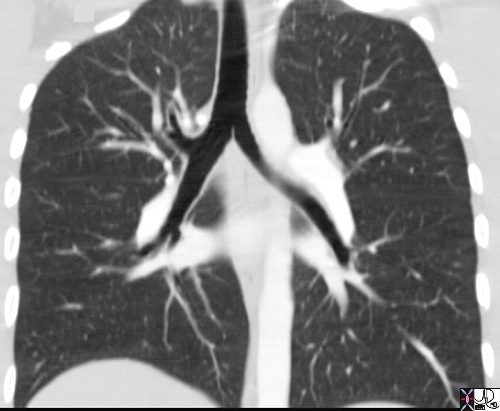
Fissures of the right lung
This coronal reformats through the tracheobronchial tree show the major fissures bilaterally. They are usually quite difficult to see and unless you know where to look you may miss them altogether. Usually there is a hint of hypovascularity along the fissure resulting in a relative lucency as can be appreciated in this examination. The fissures have been overlaid in orange in the next image. As the coronal cut proceeds posteriorly the lower lobe becomes more prominent and the upper lobes less so. If you review the lateral chest x-ray and project the cuts you would get a better sense of this concept of the dominance of the RLL and its posterior location .
Ashley Davidoff MD. TheCommonVein.net 32682b


Fissures of the right lung
This coronal reformats through the tracheobronchial tree show the major fissures bilaterally. They are usually quite difficult to see and unless you know where to look you may miss them altogether. Usually there is a hint of hypovascularity along the fissure resulting in a relative lucency as can be appreciated in this examination. The fissures have been overlaid in orange. As the coronal cut proceeds posteriorly the lower lobe becomes more prominent and the upper lobes less so. If you review the lateral chest x-ray and project the cuts you would get a better sense of this concept of the dominance of the RLL and its posterior location .
Ashley Davidoff MD. TheCommonVein.net 32682b01.jpg
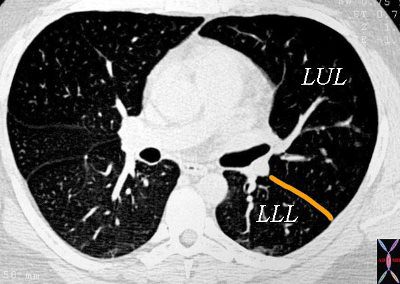
Major fissure – transverse image
This axial CT shows the major fissure (orange) of the left lobe on the CT scan separating the LUL from the LLL The anatomic specimen in the following image is in the sagittal plane. On the right side the posteriorly placed oblique (major) fissure and the anteriorly placed transverse fissure (minor) can be seen.
Courtesy Ashley Davidoff MD The CommonVein.net 32160b0
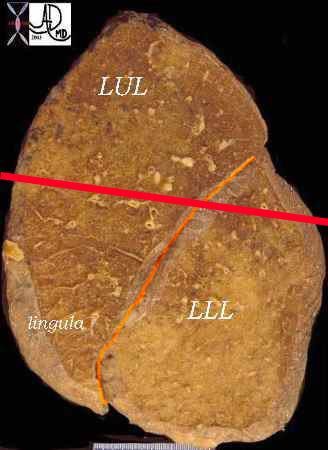
Major fissure – transverse plane
The anatomic specimen is in the sagittal plane with the posterior aspect to the left. The red line reflects the axial plane of the CT above.
Courtesy Ashley Davidoff MD The CommonVein.net 32228b04When we read plain films of the chest we use the position and relations of the lungs to the heart and the fissures to locate disease processes, including infiltrates, nodules, and regions of atelectasis. We use two principles to locate disease. The first is the described relations of structures to each other, and the second is the concept of “silhouetting.” The important facts that pertain are that the RML abuts the right heart border, the lingula the left heart border, and the lower lobes on both sides abut the diaphragm. The principle of “silhouetting” is commonly used to define the nature and location of a soft tissue process in the lung. We have described the fact that we are able to see and distinguish two different structures because their densities are different. Thus we are able to see the heart border or the diaphragm, for example, because they abut air- filled lung tissue which has a completely different density to their soft tissue nature. If, however, the ai- filled lung is replaced by pus or exudates (pneumonia) or become airless (atelectasis), then the abutting structures both have soft tissue density and cannot be distinguished from one another. If there is a process that silhouettes the right heart border in the P-A projection then we know that this process is in the RML. Similarly, if the left heart border cannot be distinguished from the disease process, we know that it is in the lingula.
It is important to identify accurately the location of disease, particularly nodules and masses which may have to be surgically removed, since the surgeon has to know which part of the lung has to be removed.


